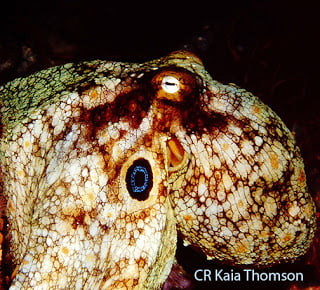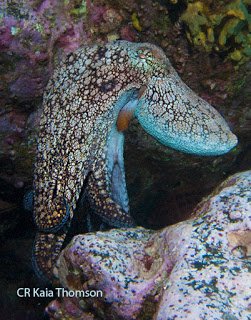 |
| California Two-Spot Octopus, The Pacific Ocean. Photo by Kaia Thomson |
To travel with Todos Santos Eco Adventures (TOSEA) is to understand their passion for what they do. Bryan and Sergio Jauregui are not just running a business, but do it for the love of the land and sea…they are always learning, always sharing. When we came across Bryan’s most recent, and fascinating, blog post, we had to share. But first, a few questions with the two of them:
KUSINI: What was your inspiration to write this article?
TOSEA: (Bryan’s voice): My sister gave us Sy Montgomery’s book, The Soul of an Octopus, for Christmas last year. We both found it absolutely charming and completely revelatory about the intelligence and emotions of octopuses. This book actually inspired omnivore Sergio to stop eating octopus! It also inspired us to do the behind-the-scenes tour at the New England Aquarium in Boston when we visited last summer and it was wonderful to meet the aquarists who are doing such great work there. I write regularly for our local Baja California Sur magazine, Journal del Pacifico, and when the editor asked if I’d like to do a piece on octopuses I jumped at the chance to dive even further into the octopus’s garden.
KUSINI: Are visitors to Baja California Sur able to see octopuses in their native environment?
TOSEA: (Sergio’s voice): Yes, we see octopuses in both the Pacific Ocean and the Sea of Cortez. Several of the 300 species of octopus can be found in Baja California Sur.
KUSINI: What are the threats to these magnificent creatures?
TOSEA: Climate change and the resulting increase in ocean acidification is one of the key threats to the octopus. When the pH level of the ocean gets too low, octopuses can’t circulate enough oxygen to survive. Octopuses are also threatened by habitat destruction and events which cause a decline in their key food sources.
KUSINI: What’s your best octopus story/sighting?
TOSEA: (Sergio’s voice): There is an octopus that lives in a conch shell right off the shore at Camp Cecil and we see him all the time with our guests – he’s quite friendly. There’s another octopus who lives near one of the dive sites near Espiritu Santo and he likes to keep a series of shells in front of his house. If we move one of the shells, even a little bit, he always comes out and fixes them back just so. Octopus are also amazing predators. One of our guides actually saw an octopus eat a bird!
The Octopus’s Garden
by Bryan Jáuregui, Todos Santos Eco Adventures
This article was originally published in Janice Kinne’s Journal del Pacifico
There was a thief in the aquarium and no one knew what to do. The institution had just recently purchased 10 Australian Pineapplefish at a price per head that brought tears to the financial officer’s eyes, and now these expensive beauties were
disappearing – eerily, quietly, and exactly one fish per night. Management’s initial hypothesis was that night-time employees were seeking to boost their fortunes by selling the fish on the black market, so they set up monitoring stations at employee exits to inspect bags and purses. No pilfered fish were found, and they kept disappearing, one fish each evening. Puzzled, and anxious to protect what remained of their investment, aquarium officials finally decided to set up a camera monitoring system at the Pineapplefish tank to try and catch the thief in the act. Turns out, it was the perfect inside job.
Three tanks away the giant Pacific octopus planned and executed the crime. He figured out how to undo the lock on his tank, walk past the (obviously less delectable) Barrier Reef Anemonefish and Bicolor Parrotfish, open the tank of the Australian Pineapplefish, and leisurely enjoy his midnight snack. He then carefully replaced the top of the Pineapplefish tank, walked back to his own tank, and put the lid back in place.
An Octopus planning? Picking a lock? Walking? The aquarium theft story is one that is widely told in marine science circles, although no one seems to remember the name of the aquarium or exactly when it happened. Even Snopes.com is not entirely sure. Yet the story has such wide currency as those who study and work with octopuses (yes, it is “octopuses” as the greek-derived word octopus will not suffer a latin ending like “I”) know an octopus could easily plan and execute such a caper. In fact, the remarkable intelligence of octopuses, coupled with their other-worldly, alien-seeming bodies, has given rise to a spate of books in recent years that explore and celebrate these amazing creatures. In Other Minds: The Octopus, the Sea and the Deep Origins of Consciousness, Peter Godfrey-Smith talks about engaging with octopuses as “probably the closest we will come to meeting an intelligent alien.” In The Soul of an Octopus Sy Montgomery tells wonderful stories about the octopus friends she made at the New England Aquarium, their personalities and their sophisticated cognitive skills of being able to imagine what is in another creature’s mind. And in Octopus! The Most Mysterious Creature in the Sea, Harmon Courage discusses how “the big-brained cephalopod can navigate through mazes, solve problems and remember solutions, and take things apart for fun.”
Mirror Minds
Octopuses and humans last shared a common ancestor (a wormlike critter) about half a billion years ago, so minds of the two groups developed into complex, sentient entities completely separately. As did their bodies, which seem to be almost the inverse of each other. Octopuses can shape-shift through cracks no larger than their eyes. Humans lack such fluidity. Vertebrates are structured around a central nervous system centered in the head, while the brains of an octopus – whose neuron numbers are comparable to those of mammals – are distributed, with two-thirds in their 8 arms and only one third in their heads. This means that the arms can engage in independent problem-solving behavior, like how to open the tank of the Australian Pineapplefish, while the owner can be checking to see if there is a similarly worthy object of its attention in another tank. As Godfrey-Smith notes, “An octopus is so suffused with its nervous system that is has no clear brain-body boundary.” Imagine.
And that’s just for starters. Vertebrates have just one heart, while octopuses have three. Two of the hearts are engaged solely in the task of moving blood beyond the gills, while the third heart is tasked with keeping circulation flowing for the organs. When an octopus swims, the organ heart actually stops beating, which explains why in many cases an octopus would rather walk, or crawl, than swim, as swimming is exhausting for them. And walking does come in handy when getting out of the water for an aquarium hunting expedition.
 |
| Common Octopus Juvenile, Sea of Cortez. Photo by Kaia Thomson |
But perhaps of all the cool things that an octopus’s brain/body can do, the most amazing is its ability to disguise itself by almost instantaneously changing not only the color and pattern of its skin, but the very texture of its skin to everything from small bumps to tall spikes to match its surroundings such that even the most determined and observant predator or prey cannot distinguish it from nearby coral, algae-covered rocks, kelp fronds or the sandy seabed. And color also denotes mood. As Sy Montgomery wrote upon meeting an octopus named Athena, “As I stroke her with my fingertips, her skin goes white beneath my touch. Later, I learn this is the color of a relaxed octopus.” Alternatively, “An agitated giant Pacific octopus turns red, its skin gets pimply, and it erects two papillae over the eyes, which some divers say look like horns.”
It is tempting to chalk up the body-changing abilities of an octopus to instinct alone, but Dr. Jennifer Mather, a comparative psychologist who studies octopuses, has found that octopuses use specific disguises for specific species in specific conditions – both offensive and defensive. That is, it is another sign of the octopus’s intelligence. Dr. Mather believes that the octopus’s loss of the ancestral shell is what lead it to develop this intelligence. Being shell-free allows the octopus to be an active predator like a lion, rather than a passive muncher like a clam. But the dozens of different prey species that it hunts require different hunting strategies, just as different strategies are required for defending itself against different predators. Dr. Mather has documented that octopuses will often use what is called the Passing Cloud display – flashing pulses of color that move across the octopus like passing clouds – to startle an immobile crab (one of its favorite foods) into moving and give itself away. To catch shrimp, octopuses have been seen to compress themselves, creep up to the shrimp, extend an arm up and over the shrimp, then touch it – an act which scares the shrimp right into the mouth of the octopus.
 |
| Common Octopus, The Pacific Ocean. Photo by Kaia Thomson |
On the other side of the equation, if an octopus is being hunted by a hungry fish it might rapidly change color, pattern and shape; fish have strong visual memories for certain images, and if an octopus is rapidly changing from light to dark, from spots to stripes, the fish can’t place it and moves on to something it can identify to eat. But if that psychedelic display is not enough, octopuses have many more tricks in their bag – including the ability of some species to deploy a pseudomorph, a life-size self-portrait made from a cloud of ink and mucus. This essentially freaks out and disorients the predator, allowing the octopus to get away. It seems that octopuses actually enjoy messing with the (lesser) minds of would-be predators. The mimic octopus, rather than making itself look like something passive such as coral or rock to avoid detection, transforms itself to look and act like venomous creatures such as jellyfish, sea snakes and spiky lionfish to send its would-be predator running the other way.
Octopuses also employ tools for defense. Researchers in Indonesia have documented octopuses lugging half coconut shells across the ocean floor, assembling them into spheres, and climbing inside for protection. An octopus at the Middlebury octopus lab found that a sea urchin was hanging around too close to its den so she ventured out, found a piece of flat slate, and erected it in front of her den like a shield.
As Sy Montgomery notes, “…of all the creatures on the planet who imagine what is in another creature’s mind, the one that must do so best might well be the octopus – because without this ability, the octopus could not perpetrate its many self-preserving deceptions. An octopus must convince many species of predators and prey that it is really something else….(then) assess whether the other animal believes its ruse or not, and if not, try something different. “Writes Godfrey-Smith, “When surviving requires decision-making, brains have developed awareness. Sentience,” he notes, “has some point to it.”
Love and Friendship
 |
| Common Octopus. The Pacific Ocean. Photo by Kaia Thomson |
Montgomery, Godrey-Smith and numerous others have documented that octopuses can readily distinguish different people, even if they are wearing identical uniforms, and that they have very particular feelings about those different people. With people that they like, they will touch them, hold their hands and arms, give them gentle squeezes, and allow themselves to be stroked. They are friendly and engaged and will readily come to the surface of their tank for interaction. People that they don’t like may be subjected to rude squirts of water and – if the visitor is too close – even a bite. But what about with each other? Every Valentine’s Day the Seattle Aquarium hosts the Octopus Blind Date, in which the partition between the tanks of a male and female giant Pacific octopus is lifted and nature is allowed to take its course – six hearts beating as three might be the romantic view. But in 2016 the blind date was cancelled due to fears that the 70-pound male, Kong, would simply find his 35-pound date a tasty snack, a decidedly unromantic outcome. While it was a loss for Seattle’s octopus sex voyeurs, it was a new lease on life for Kong. Mating, while ensuring the survival of the species, is a death knell for male octopuses, who die shortly thereafter. This close link between sex and death might account for some octopuses rather hands-off approach to sex – literally. The males and females of the Algae octopus will find houses next to one another so that the male only has to reach his hectocotylus (sex arm) out his front door and into her’s to get the job done. The Argonaut octopus doesn’t even get that intimate. Males simply detach their hectocotylus and send it off to mate with a passing female.
Female octopuses can lay up to 400,000 eggs, which they attach to the ceiling of their dwelling and lay in long strings like translucent ropes of pearls. They guard and tend their eggs diligently until they hatch. Sy Montgomery reports how her octopus friend Octavia in the New England Aquarium wove her egg chains and tended them with meaningful rituals, even though there was no male to fertilize them. Of course the eggs never hatched and Octavia succumbed to death a few months later, as do all female octopuses once their reproductive cycle is over.
The Octopus’s Garden
Octopuses are the blue bloods of the marine world. Truly. Octopuses evolved a copper rather than an iron-based blood, and it’s the copper that turns their blood blue. Copper is more efficient at transporting oxygen than hemoglobin in deep ocean environments, where water temperatures are low and there is not much oxygen. But this system also means that octopuses are very sensitive to changes in acidity, and when the ocean’s pH gets too low, octopuses can’t circulate enough oxygen. There is therefore a great deal of concern in the scientific community about what will happen to octopuses with the increasing ocean acidification being brought about by climate change.
Octopuses have existed on the earth for at least 296 million years, the age of the oldest known octopus fossil. That’s over a thousand times longer than humans. “The sea is the original birth place of the mind. When you dive into the sea, you are diving in to the origin of us all’” writes Godfrey-Smith. It is perhaps for this reason that Godfrey-Smith dedicates his book to “all those who work to protect the oceans.” As Carl Safina notes, “As we change the world, let’s bear this in our minds: Other minds are living their own lives here with us on earth.”
In Baja California Sur our two oceans, the Pacific and the Sea of Cortez, are filled with many of the 300 species of octopus that inhabit the world, and it is possible to visit many octopus gardens and match wits with these amazing creatures when snorkeling and diving. Jacques Cousteau, who called the Sea of Cortez the Aquarium of the World, tells a charming story in his 1973 book Octopus and Squid: The Soft Intelligence. “Our friend Gilpatric … brought an octopus home and put it in an aquarium, which he then covered with a heavy lid. A short time later, the aquarium was empty, and Gilpatric found the octopus going through his library, book by book, turning the pages with its arms.” And that’s a true octopus story.
© Copyright Sergio and Bryan Jauregui, Casa Payaso S de RL de CV, 2017



Leave A Comment
You must be logged in to post a comment.